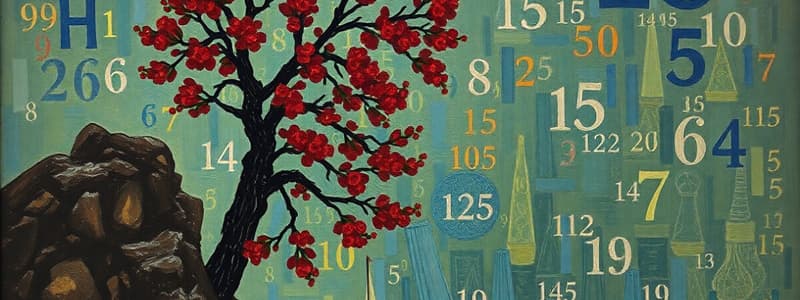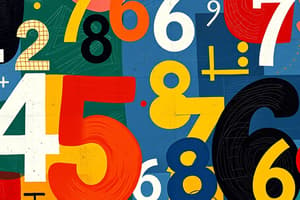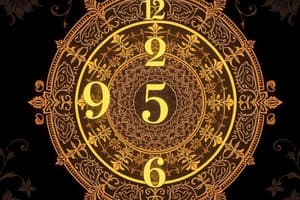Podcast
Questions and Answers
If the LCM of two numbers is 210 and their HCF is 14, and one of the numbers is 42, what is the other number?
If the LCM of two numbers is 210 and their HCF is 14, and one of the numbers is 42, what is the other number?
- 70 (correct)
- 56
- 84
- 63
Which of the following numbers is divisible by 11?
Which of the following numbers is divisible by 11?
- 987654
- 864209 (correct)
- 123456
- 753190
What is the sum of the first 20 terms of the arithmetic progression: 2, 5, 8, 11, ...?
What is the sum of the first 20 terms of the arithmetic progression: 2, 5, 8, 11, ...?
- 650
- 590
- 630
- 610 (correct)
If a number N is divisible by both 9 and 10, then it must be necessarily divisible by which of the following?
If a number N is divisible by both 9 and 10, then it must be necessarily divisible by which of the following?
What is the value of $\frac{2}{5} + \frac{1}{3} \times \frac{3}{4}$?
What is the value of $\frac{2}{5} + \frac{1}{3} \times \frac{3}{4}$?
Find the number of zeros at the end of the product: 15 × 25 × 4 × 44 × 16 × 55 × 125.
Find the number of zeros at the end of the product: 15 × 25 × 4 × 44 × 16 × 55 × 125.
What is the remainder when $3^{256}$ is divided by 5?
What is the remainder when $3^{256}$ is divided by 5?
If the average of 10 numbers is 20, and the average of another 15 numbers is 30, what is the average of all 25 numbers?
If the average of 10 numbers is 20, and the average of another 15 numbers is 30, what is the average of all 25 numbers?
Simplify: $\frac{(a^2 - b^2)}{(a + b)}$
Simplify: $\frac{(a^2 - b^2)}{(a + b)}$
A train travels at a speed of 60 km/h and covers a distance of 300 km. How long does it take to complete the journey?
A train travels at a speed of 60 km/h and covers a distance of 300 km. How long does it take to complete the journey?
If $x + \frac{1}{x} = 5$, then what is the value of $x^2 + \frac{1}{x^2}$?
If $x + \frac{1}{x} = 5$, then what is the value of $x^2 + \frac{1}{x^2}$?
A sum of money doubles itself in 6 years at simple interest. In how many years will it become 4 times itself?
A sum of money doubles itself in 6 years at simple interest. In how many years will it become 4 times itself?
What is the value of $\sqrt{16 + \sqrt{16 + \sqrt{16 + ...}}}$?
What is the value of $\sqrt{16 + \sqrt{16 + \sqrt{16 + ...}}}$?
Two numbers are in the ratio 3:5. If 9 is subtracted from each, the new numbers are in the ratio 12:23. What is the smaller number?
Two numbers are in the ratio 3:5. If 9 is subtracted from each, the new numbers are in the ratio 12:23. What is the smaller number?
Find the value of: $(256)^{0.16} \times (256)^{0.09}$
Find the value of: $(256)^{0.16} \times (256)^{0.09}$
A can do a piece of work in 10 days, and B can do it in 15 days. How many days will they take to complete the work together?
A can do a piece of work in 10 days, and B can do it in 15 days. How many days will they take to complete the work together?
If the cost price of 12 articles is equal to the selling price of 9 articles, what is the profit percentage?
If the cost price of 12 articles is equal to the selling price of 9 articles, what is the profit percentage?
The population of a town increases by 10% annually. If the present population is 21000, what was its population 2 years ago?
The population of a town increases by 10% annually. If the present population is 21000, what was its population 2 years ago?
A boat can travel 20 km downstream in 2 hours and 10 km upstream in 2 hours. What is the speed of the stream?
A boat can travel 20 km downstream in 2 hours and 10 km upstream in 2 hours. What is the speed of the stream?
If a = 2 and b = 3, find the value of $(a + b)^b$
If a = 2 and b = 3, find the value of $(a + b)^b$
Flashcards
Natural Numbers
Natural Numbers
Counting numbers starting from 1. (1, 2, 3, ...)
Whole Numbers
Whole Numbers
All natural numbers including zero. (0, 1, 2, 3, ...)
Integers
Integers
All whole numbers and their negative counterparts. (... -3, -2, -1, 0, 1, 2, 3, ...)
Rational Numbers
Rational Numbers
Signup and view all the flashcards
Irrational Numbers
Irrational Numbers
Signup and view all the flashcards
Real Numbers
Real Numbers
Signup and view all the flashcards
Complex Numbers
Complex Numbers
Signup and view all the flashcards
Prime Number
Prime Number
Signup and view all the flashcards
Composite Number
Composite Number
Signup and view all the flashcards
Divisibility by 2
Divisibility by 2
Signup and view all the flashcards
Divisibility by 3
Divisibility by 3
Signup and view all the flashcards
Divisibility by 5
Divisibility by 5
Signup and view all the flashcards
Factor
Factor
Signup and view all the flashcards
Multiple
Multiple
Signup and view all the flashcards
Highest Common Factor (HCF)
Highest Common Factor (HCF)
Signup and view all the flashcards
Least Common Multiple (LCM)
Least Common Multiple (LCM)
Signup and view all the flashcards
Place Value
Place Value
Signup and view all the flashcards
Face Value
Face Value
Signup and view all the flashcards
Proper Fraction
Proper Fraction
Signup and view all the flashcards
Improper Fraction
Improper Fraction
Signup and view all the flashcards
Study Notes
- The number system serves as a method to represent numbers, which are abstract mathematical constructs employed in both counting and measurement.
- Symbols and rules vary across different number systems for representing numbers.
Types of Numbers
- Natural Numbers: Counting numbers begin at 1 (e.g., 1, 2, 3,...).
- Whole Numbers: Consist of natural numbers along with zero (e.g., 0, 1, 2, 3,...).
- Integers: Include whole numbers and their negative counterparts (e.g., ... -3, -2, -1, 0, 1, 2, 3,...).
- Rational Numbers: Can be written as a fraction p/q with p and q as integers, where q is not zero (e.g., 1/2, -3/4, 5, 0.75).
- Irrational Numbers: Cannot be expressed as a simple fraction, possessing non-terminating and non-repeating decimal representations (e.g., √2, π).
- Real Numbers: Encompass all rational and irrational numbers.
- Complex Numbers: Formed as a + bi, where a and b represent real numbers, and i stands for the imaginary unit (√-1).
Prime and Composite Numbers
- Prime Number: A natural number greater than 1, divisible only by 1 and itself (e.g., 2, 3, 5, 7, 11).
- Composite Number: A natural number greater than 1 that has divisors other than just 1 and itself (e.g., 4, 6, 8, 9, 10).
- The number 1 is neither prime nor composite.
Divisibility Rules
- Divisibility by 2: A number is divisible by 2 if its last digit is even (0, 2, 4, 6, 8).
- Divisibility by 3: A number is divisible by 3 if the sum of its digits is divisible by 3.
- Divisibility by 4: A number is divisible by 4 if the number formed by its last two digits is divisible by 4.
- Divisibility by 5: A number is divisible by 5 if its last digit is 0 or 5.
- Divisibility by 6: A number is divisible by 6 if it is divisible by both 2 and 3.
- Divisibility by 8: A number is divisible by 8 if the number formed by its last three digits is divisible by 8.
- Divisibility by 9: A number is divisible by 9 if the sum of its digits is divisible by 9.
- Divisibility by 10: A number is divisible by 10 if its last digit is 0.
- Divisibility by 11: A number is divisible by 11 if the difference between the sum of its digits at odd places and the sum of its digits at even places is either 0 or divisible by 11.
Factors and Multiples
- Factor: An integer that divides the number evenly (without leaving a remainder).
- Multiple: An integer that results from multiplying the number by an integer.
- Highest Common Factor (HCF): The largest factor shared by two or more numbers; also known as the Greatest Common Divisor (GCD).
- Least Common Multiple (LCM): The smallest multiple shared by two or more numbers.
Finding HCF and LCM
- Prime Factorization Method: Express each number as a product of its prime factors.
- HCF: Take the product of the common prime factors with the lowest powers.
- LCM: Take the product of all prime factors with the highest powers.
- Division Method: Repeatedly divide the numbers by their common factors.
Relationship between HCF and LCM
- For two numbers a and b: HCF(a, b) × LCM(a, b) = a × b
Decimal System
- A base-10 number system.
- Utilizes ten digits (0-9).
- Each digit's position in a number corresponds to a power of 10 (e.g., ones, tens, hundreds).
Place Value and Face Value
- Place Value: The value of a digit contingent on its position within the number (e.g., in 345, the place value of 4 is 40).
- Face Value: The digit's inherent value (e.g., in 345, the face value of 4 is 4).
Fractions
- Proper Fraction: The numerator is less than the denominator (e.g., 2/5).
- Improper Fraction: The numerator is greater than or equal to the denominator (e.g., 7/3).
- Mixed Fraction: A combination of a whole number and a proper fraction (e.g., 2 1/3).
Operations on Fractions
- Addition/Subtraction: Fractions must have a common denominator.
- Multiplication: Multiply the numerators and the denominators.
- Division: Invert the second fraction and multiply.
Simplification
- BODMAS/PEMDAS rule dictates the order of operations:
- Brackets / Parentheses
- Orders / Exponents
- Division
- Multiplication
- Addition
- Subtraction
- Expressions should be simplified following this order.
Remainders
- The remainder represents the quantity "left over" when one number is divided by another.
- The Remainder Theorem can be applied to determine remainders when dividing polynomials.
Number of Zeros at the End of an Expression
- Count the pairs of 2s and 5s in the expression's prime factorization.
- The number of these pairs corresponds to the number of zeros at the end of the expression; typically, the count of factors of 5 is the determining factor, as 2s are usually more abundant.
Successive Division
- A number is divided by several divisors successively.
- To find the original number, work backwards from the last remainder.
Algebraic Formulae
- (a + b)² = a² + 2ab + b²
- (a - b)² = a² - 2ab + b²
- (a + b)³ = a³ + 3a²b + 3ab² + b³
- (a - b)³ = a³ - 3a²b + 3ab² - b³
- a² - b² = (a + b)(a - b)
- a³ + b³ = (a + b)(a² - ab + b²)
- a³ - b³ = (a - b)(a² + ab + b²)
Modular Arithmetic
- Focuses on remainders after division.
- a ≡ b (mod m) indicates that a and b yield the same remainder when divided by m.
- Calculations involving large numbers can be simplified by concentrating on remainders.
Progressions
- Arithmetic Progression (AP): A sequence with a constant difference between consecutive terms.
- nth term: a + (n - 1)d, where a is the first term and d is the common difference.
- Sum of n terms: (n/2)[2a + (n - 1)d] or (n/2)(a + l), where l is the last term.
- Geometric Progression (GP): A sequence where the ratio between consecutive terms remains constant.
- nth term: ar^(n-1), where a is the first term and r is the common ratio.
- Sum of n terms: a(1 - r^n) / (1 - r) if r < 1, or a(r^n - 1) / (r - 1) if r > 1.
- Sum to infinity (for |r| < 1): a / (1 - r)
- Harmonic Progression (HP): A sequence formed by reciprocals that constitute an arithmetic progression.
Surds and Indices
- Surd: An irrational number expressed as the nth root of a positive integer (e.g., √2, ∛5).
- Index: The power to which a number is raised, also known as an exponent.
- Laws of Indices:
- a^m * a^n = a^(m+n)
- a^m / a^n = a^(m-n)
- (a^m)^n = a^(mn)
- (ab)^n = a^n * b^n
- (a/b)^n = a^n / b^n
- a^0 = 1
- a^(-n) = 1 / a^n
Approximation
- Rounding off numbers to estimate the answer.
- Useful for quick calculations and checking the reasonableness of answers.
Word Problems
- Translate the word problem into mathematical expressions.
- Identify the unknowns and the given information.
- Use relevant formulas and concepts to solve for the unknowns.
- Check if the answer makes sense in the context of the problem.
Studying That Suits You
Use AI to generate personalized quizzes and flashcards to suit your learning preferences.




